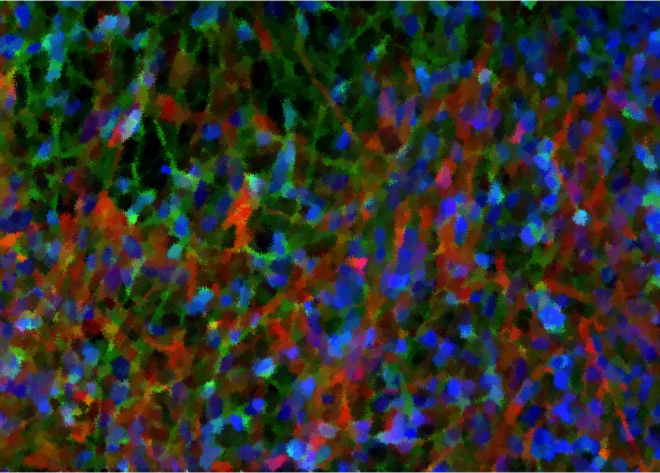Neurons modify the genome in various ways creating a genetic mosaic in our brains. What does that mean?
A mosaic is a collage of varying substances of different textures and colors that come together as a cohesive piece of art. There need be no rhyme or reason to a mosaic. It is the variance in form, its inconsistency that makes it beautiful.
Mosaic is the last word you expect to find applied to the genetics of the human brain.
The central dogma of human genetics is the opposite of variant. We think of our genetic code as consistent and sacrosanct from cell to cell – almost a definition of who we are. Furthermore, DNA replication and protein synthesis are highly controlled, very specific processes. They need to be – if the correct cogs are not created at exactly the right time, the machine cannot operate properly. When “the machine” is a human body, operability is a matter of life or death.
Why, then, are scientists from Fred Gage’s lab at the Salk Institute and various other Universities likening the genetics of the human brain to a mosaic? It turns out that the inner workings of the human brain are more varying than we initially imagined. Neuronal DNA in human neurons they find, are highly mutated, with up to 40 percent of neurons in the human brain containing DNA with long portions of deleted or duplicated code. What this means is that the genomes of our neurons have been clipped, modified or copied differently within each neuron over our lifetime. This adds up to thousands of mutations within each neuron, hardly the quintessential fulfillment of molecular order that scientists had imagined. Mike McConnell, an author on the paper, emphasizes that this finding changes the very questions neuroscientist are asking: “We’re no longer saying, ‘Do neurons have different genomes? We’re saying, ‘Let’s figure out how that matters.’”
One way it matters is in gene expression. We have long known that not all genes are expressed in the same way. Some are never expressed. Others only debut at certain times or under specific conditions. Location matters, too. The way genes are read and built into cellular workers is different in the stomach than in the liver, skin, or eyes. These organs need different workers. Selective gene expression allows each to get the molecular workers they need and to avoid producing workers that would be detrimental to the function of that organ. An acidic stomach enzyme, for example, would wreak havoc on the human eye.
Gene expression in the brain is particularly important. The brain is the organ through which we perceive and experience the world, and the human brain is a masterpiece. When compared to other mammals, our brains exhibit the highest levels of gene expression. Though we can’t be sure why, current hypothesis is that this allows the human brain to operate at higher levels of neuronal activity. The specifics of gene expression in the brain, however, are still being brought to light. The more we learn, the more complicated the picture becomes. Recent research, for example, reveals that environment plays an enormous role in gene expression – read more about that here. More specifically, experiences have a profound impact on which genes are expressed in your brain. In turn, in animal studies, gene expression has been linked to performance on different tasks.
Neuronal genomic diversity adds one more layer of complication to the functioning of your brain. Not only are genes being expressed selectively and in response to variable environmental stimuli, the very code being expressed differs between individual neurons. It is no surprise, then, that gene expression in the brain varies wildly among us.
Since gene expression is the production of various molecules that define neuronal function, differences will no doubt have a direct functional consequence that will be visible in functional readouts of brain activity. Eventually we will find the links between genomic differences, gene expression and their functional and behavioral outcomes. The larger message however, is that the differences among individuals perpetuate at every level from genes to functional readouts to behavior. What is true for one person may not be so for another. This cautions against generalizing results from small studies and makes it imperative to understand the diversity of function among us. While studying neuronal genomes and gene expression at large scale is a difficult task (you need post mortem brains to do this), we can more readily understand functional differences with EEG, an easily accessible functional readout of the brain (see Taking Neurotechnology out of the Lab). Participation in the Human Brain Diversity Project is one way to contribute to this monumental task of understanding the variability among us.
I’ll leave you with an inspiring quote from Dr. Gene E. Robinson:
Brains do more than direct our behavior. They build our experiences into a coherent perception of the world. This world will be as unique for each of us as our personal history, with the potential to be sunny, or cloudy, or filled with shadows. If we can become proficient in the code our brains run on, perhaps we can learn to give these narratives a nudge in the right direction, and flood every person’s world with light.
















